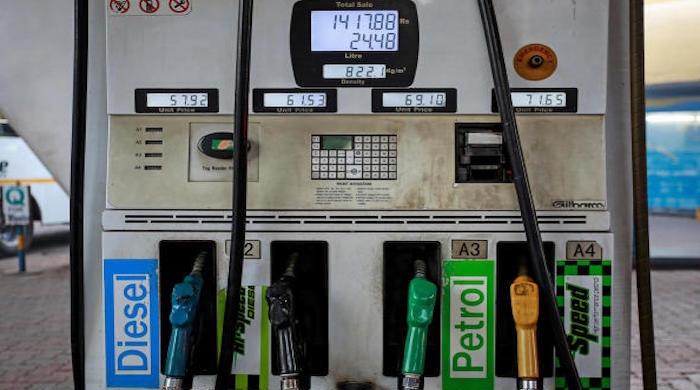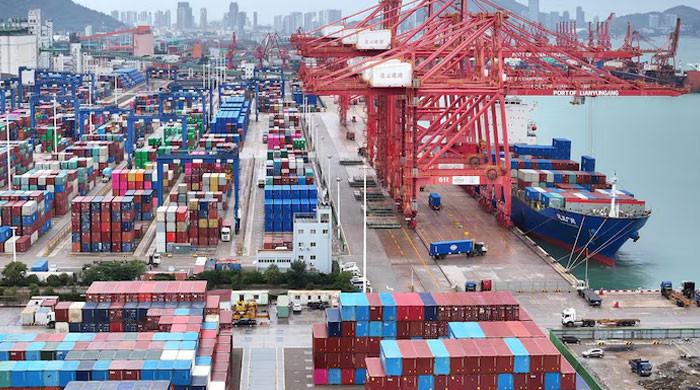Inflation to remain on 'higher trajectory', warns finance ministry
Inflationary pressure in May is expected to continue as observed in month of April, finance ministry projects
May 31, 2023

- Inflation for May likely to remain in the range of 34-36%.
- Ministry expects political stability to help achieve price stability.
- Remittances likely to increase in coming months due to Eid.
ISLAMABAD: Despite the constant efforts of the coalition government, Pakistan is still reeling from one of its worst economic and political crises which has impacted the masses.
Keeping in view the current situation, the Ministry of Finance has once again warned of challenges emanating from uncertain external and domestic economic environments, including higher inflation and external debt repayments, due to lesser foreign exchange inflows.
The ministry, in its monthly outlook bulletin, projected that the inflation for the month of May will remain in the range of 34-36%.
“Pakistan's economy experienced 0.29% provisional GDP growth in the fiscal year 2022-23 on account of many challenges emanating from the uncertain external and domestic economic environment.
"The challenges triggered CPI inflation to remain on a higher trajectory despite monetary tightening primarily due to the rupee depreciation. External payments also remained burdened due to lesser foreign exchange inflows,” the ministry stated.
Inflationary pressure in May is expected to continue as observed in the month of April. “The potential reasons for rising price level are flood damages, disruptions in supply chains, devaluation brought by the macro-economic imbalances and political uncertainty,” it added.
However, improvement in the global supply chain will ease domestic prices in the coming months. The global commodity prices fell 14% in the first quarter of 2023 and by end-March, they were roughly 30% lower than their historic peak in June 2022.
The favourable international commodity price outlook is expected to offset the negative impact of currency depreciation. In addition, the better crop outlook due to timely measures i.e. Kissan Package and expected political stability would help achieve price stability.
The recent decrease in administered prices of petrol and diesel prices will be transmitted into lower domestic prices of essential items by impacting the transportation cost.
The report mentioned fiscal consolidation, adopted by the government during the outgoing year, supported economic sustainability.
Rehabilitation of agricultural activities during the Kharif season will also have a positive effect on economic growth. Overall, the appropriate policy mix is expected to bring prosperity, economic growth and an improved supply chain.
The current performance of fiscal indicators indicates effective consolidation through various revenue rising and expenditure management strategies.
However, there are certain downside risks to the financial sector towards the end of the current fiscal year. These risks may emerge due to higher-than-expected expenditures mainly due to a rise in debt servicing costs and higher expenditures for flood rehabilitation activities.
Similarly, on the revenue side, the Federal Board of Revenue (FBR) tax collection increased by 16.1% during July-April FY23. However, it remained less than the target. The slowdown in economic activity and import compression explain a substantial portion of the lower-than-expected tax revenue during the review period.
Recognising these issues, the government is taking effective steps to reduce non-productive spending through austerity measures and focus on targeted subsidies.
On the revenue side, the FBR is working hard to boost tax collection through different policy and administrative initiatives in the aftermath of a challenging economic environment, both at domestic and international levels.
All of these actions would help manage fiscal imbalances while keeping fiscal deficit under control and the primary balance at a sustainable level.
Sector-wise outlook
Agriculture: Kharif crops 2023 sowing is in progress. Sufficient agriculture inputs available to the farmers along with better product prices in the market will incentivise farmers to achieve sowing targets. Further, it is expected favourable weather and climatic condition will help in better yield of the crops.
Industrial activities: The cyclical position in Pakistan’s main export markets showing some signs of stability since January 2023. However, large-scale manufacturing (LSM) activity is recorded below its natural capacity level since the start of FY23 owing to necessary policy measures to cool down the overheated economy and to avoid default on its external liabilities.
The downside risks pertaining to supply disruptions, inflationary pressures, synchronised policies and high base effect are continued to prevail, which will have an impact on the LSM output in the coming month.
According to the balance of payment data, exports of goods and services declined by 31.6% and 14.8% on a year-on-year and month-on-month basis, respectively imports of goods and services decreased by 38% and 5.4% respectively on an annual and monthly basis.
However, the trade deficit of goods and services decreased by 45.4% on a year-on-year basis, while it increased by 12.5% on a monthly basis in April.
The Real Effective Exchange Rate (REER) stabilised, which implies Pakistan’s inflation differential has been largely compensated by the nominal depreciation of the rupee exchange rate. For the remaining months, the ministry expects exports and imports will follow their trend pattern as observed during the second half of the outgoing fiscal year.
Meanwhile, remittances decreased by 12.9% on a monthly basis and returned to a normal trend after observing a spike in the month of March due to Eid-related factors.
"It is expected remittances will increase in coming months due to Eid and other improvements in global and domestic environment. Taking into account all other secondary and primary income payments and receipts, the current account deficit is expected to remain within the sustainable limit," the report concluded.











